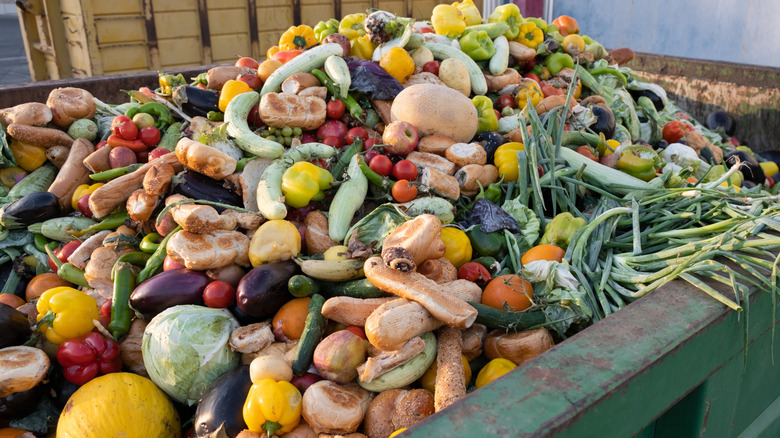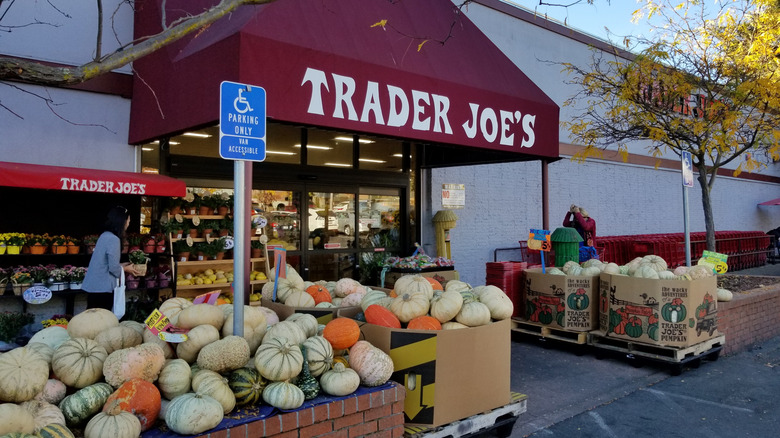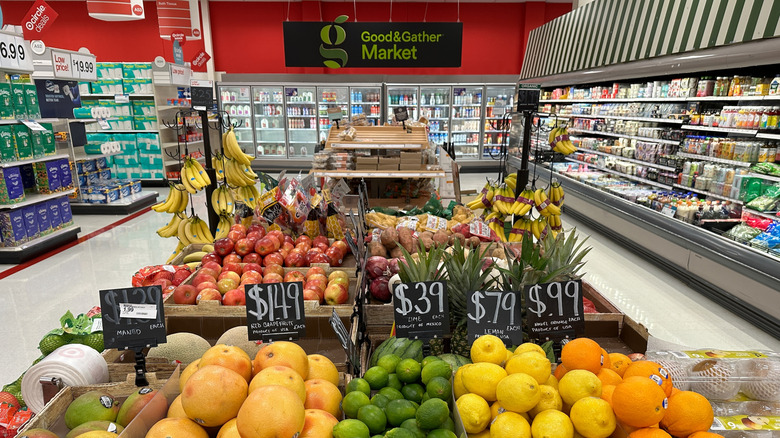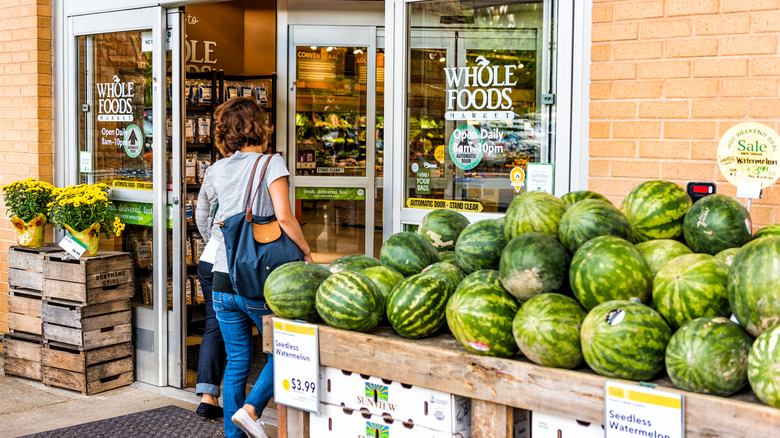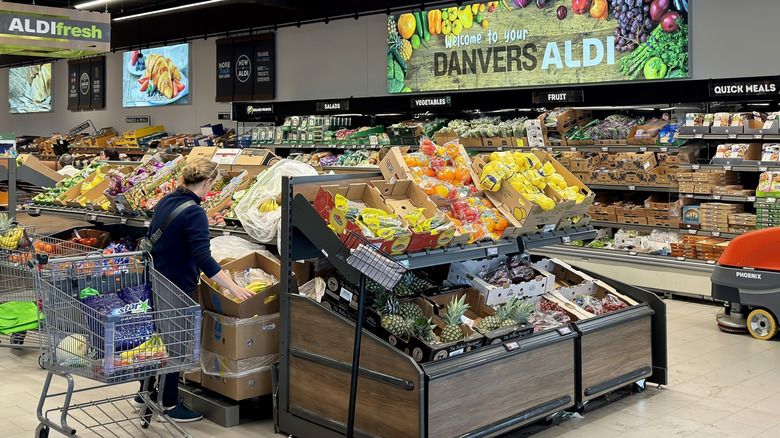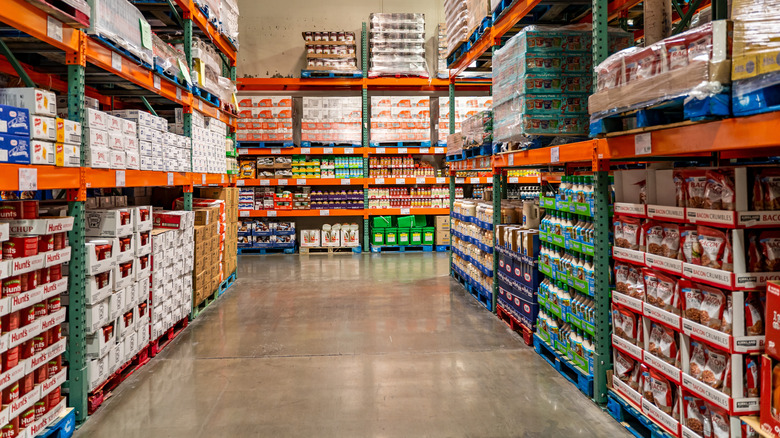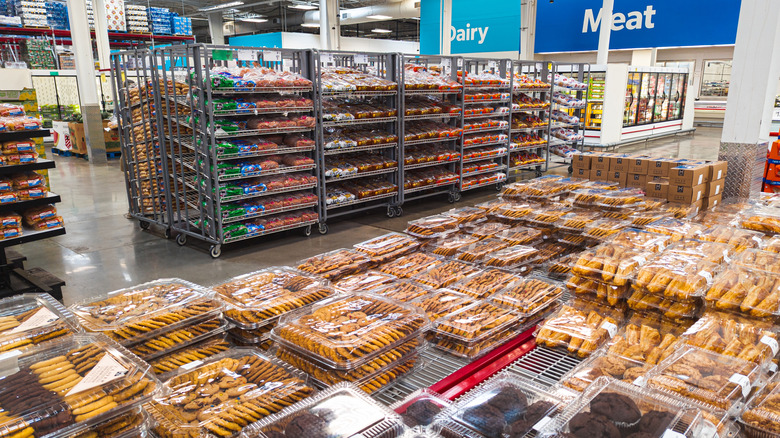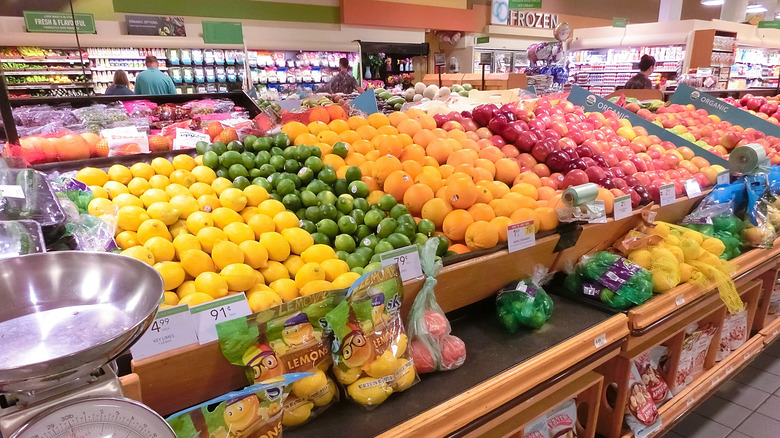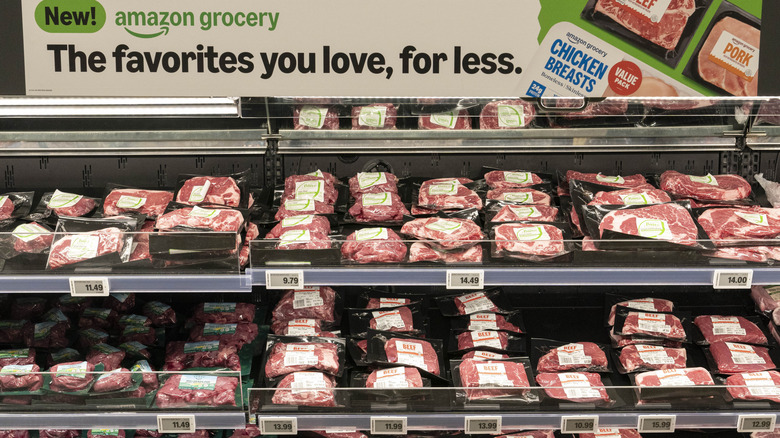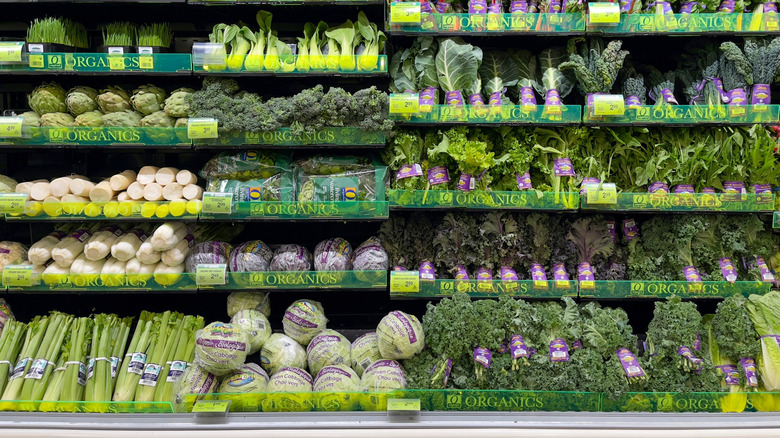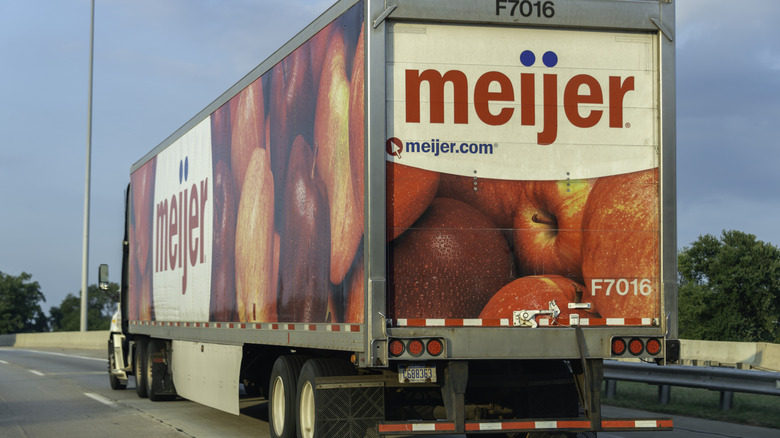How America's Most Popular Supermarkets Handle Their Unsold Groceries
Walk through the automatic doors of your typical American grocery store and you'll be greeted by shelves brimming with fresh produce, meat, baked goods, and every dairy product imaginable. But have you ever wondered what happens to all the food that doesn't go home with customers? According to ReFED, a national nonprofit focused on food waste solutions, 63 million tons of food is thrown away in America every single year.
Food waste is a complex challenge. As food waste piles up in landfills, it contributes to irreversible environmental changes, including global warming. But there's another problem looming: 47 million people in our country don't have enough to eat, with one in 5 kids facing food insecurity.
While these statistics are disheartening, American supermarkets are at the forefront of tackling this paradox of over-abundance and need. Many retailers have committed to USDA and EPA efforts to reduce food loss and waste by 50% by 2030. Others are embracing new technologies and creative solutions, from donating unsold but still edible groceries to food banks, to recycling and composting inedible scraps. The truth is, we all have a personal responsibility to reduce food waste, but it's always heartening to know how corporations are tackling the issue, too. Here's how your neighborhood grocery store is using unsold food to fuel a movement for good.
Trader Joe's
Trader Joe's runs an impactful food recovery program at all of its stores nationwide. This begins at the crew member level. Seven days a week, its workers actively remove any groceries that no longer meet quality standards. These could be items approaching their expiration date, misshapen produce, or products with damaged packaging. Trader Joe's shelves are typically restocked overnight or early in the morning, donating 100% of unsold food that's still safe to consume to local non-profit organizations through Trader Joe's Neighborhood Shares program.
According to Trader Joe's, each store employs a donation coordinator to oversee contributions to the community. In 2024 alone, the grocery chain donated over 98 million pounds of high-quality groceries to more than 2,000 food banks and hunger-relief organizations across the country. If the food can't be used for human nourishment, it's often used by local farmers for compost. For example, a rancher known as Cowboy Max shared a TikTok in 2022 thanking his local Trader Joe's for two bins of pumpkins that helped feed his livestock. "They could have just put them right in the dumpster," Max explained, explaining how the unsold gourds would be utilized on the farm. "The very last, last resort would be throwing [excess food] away, but we don't ever want to throw it away when we have great nutritious food for people, animals, or producing more food," he added.
Target
Target has come a long way in reducing operational food loss. The company hit its goal to cut food waste by 50% for two consecutive years through improved inventory management, recycling, composting, and food donation programs. In 2023, Target gave 154.8 million pounds of food — the equivalent of 113 million meals — to food banks and community organizations.
In the Chicago area, some neighborhood Target stores are part of a unique hub-and-spoke partnership with the Greater Chicago Food Depository. The organization connects food pantries with nearby retailers so they can rescue unsold food and redirect it to households facing food insecurity. While some fresh produce, proteins, and shelf-stable foods are making it to dinner tables instead of dumpsters, Target still faces ongoing challenges as a large-scale retailer. Reddit posts by Target employees highlight frequent concerns about having to throw out products from malfunctioning freezers and garbage bins full of unopened food. Though grocery policies are set by Target corporate, it seems the actual execution and commitment to food donation may vary greatly by store location and management.
Whole Foods Market
Whole Foods Market is one of over 45 corporations named a U.S. Food Loss and Waste 2030 Champion by the USDA. That means that by the year 2030, the natural and organic grocery store chain has pledged to cut its food waste in half. To accomplish this goal, Whole Foods is taking cues from the EPA's Wasted Food Scale, a hierarchy that prioritizes alternative solutions to unnecessarily wasting food.
Inside Whole Foods stores, unsold or imperfect produce is repurposed into smoothies, prepared dishes, or baked goods. For example, unused portions of fish are utilized for soups, smoked salmon, or other offerings on the seafood counter. On the donation front, Whole Foods has a partnership with Food Donation Connection, and it has also launched a large-scale Nourishing Our Neighborhoods program across the U.S., Canada, and the U.K. By funding the purchase of refrigerated vans, Whole Foods is able to transport produce, meat, and prepared goods to food banks or rescue organizations. In total, Nourishing Our Neighborhoods has provided over 182 million meals while simultaneously diverting food from landfills. When unsold food can't be repurposed or donated, many Whole Foods stores participate in food waste diversion programs that create compost, animal feed, or renewable energy.
Aldi
The typical neighborhood Aldi is much smaller in size than most other major grocery stores. When it comes to reducing food waste, that's an advantage: Aldi store shelves only have space for the best-selling products. While Aldi produces less waste by selling less stuff, it still aims to cut waste in half by 2030. As a U.S. Food Loss & Waste 2030 Champion, the discount grocer has made a public pledge to increase food donations. It has also introduced organic recycling programs and implemented more efficient food ordering systems.
Aldi already has a longstanding partnership with Feeding America, a food rescue organization that serves over 200 food banks and 60,000 meal programs nationwide. This helps Aldi not only make a difference in the community but also reduce its environmental impact. In 2021 alone, Aldi donated 33 million pounds of food that was deemed inappropriate for sale but still safe to consume. That same year, Aldi's organic recycling program at its corporate store in Batavia, Illinois, and select other locations redirected 1.9 million pounds of inedible food waste from landfills.
Costco
Costco arguably has one of the most comprehensive and transparent plans to reduce food waste. The chain follows EPA's Wasted Food Scale and finds several alternative uses for food items that may otherwise go to waste. For example, leftover rotisserie chicken is repurposed into new member offerings like chicken noodle soup and pot pies. Unsold ground beef is used for the likes of deli stuffed peppers or meatloaf.
The company's efforts to minimize waste also include prioritizing food donations to help tackle food insecurity. Its warehouses contributed over 145 million pounds of food to Feeding America and other food service agencies in 2024. In addition to Costco's unsold bakery items, 72% of these donations included nutritious fruits and vegetables, proteins, and dairy products essential to health and well-being.
When unsold food isn't fit for upcycling or donation, Costco diverts organic materials to local feed programs at animal sanctuaries, rescue centers, farms, and zoos. It also recycles organic waste to create other products, such as fertilizer and soil conditioners. Once again proving the versatility of its rotisserie chickens, the residual grease from the roasting process is also converted into biofuel.
Kroger
Kroger operates a wide range of grocery stores with well-known regional names across the country. In your neck of the woods, it could be Ralphs, Fred Meyer, Fry's, Mariano's, King Soopers, or Pick'n Save. In 2017, the corporation launched its Zero Hunger Zero Waste impact program to make positive changes at local, national, and global levels. Food rescue is a big part of the plan. Kroger regularly donates unsold food to Feed America's network of hunger relief agencies. The company reported that all of its stores participated in its food rescue scheme in 2023, donating 114 million pounds of food throughout the year.
The chain is aware that it has a responsibility to cut food waste. As Denise Osterhues, Kroger's senior director of environmental, social and governance and president of The Kroger Co. Zero Hunger Zero Waste Foundation, previously explained, "It's clear that as a grocery retailer, Kroger has a unique role to play in the future of food, from the way it is produced and transported to the way it is purchased and consumed." In addition to donating 3.4 billion meals between 2017 and 2023, Kroger has also focused on optimizing its ordering systems and making it easier for people to shop for fresh, affordable food. As deli, dairy, produce, meat, and bakery foods approach use-by dates, Kroger activates generous markdowns to ensure as little goes to waste as possible. Surplus that cannot be safely donated or sold goes to food waste recycling for animal feed, composting, or anaerobic digestion programs.
Walmart and Sam's Club
Walmart is the largest grocery store chain in the United States based on the number of stores, revenue, and overall market presence. When it comes to unsold food, the corporation follows a comprehensive Food Disposition Pyramid that prioritizes repurposing food, reducing prices, donating excess products, and recycling before turning to landfill disposal. Walmart stores also explore creative ways to use leftovers. For example, rotisserie chicken can be turned into chicken salad, while French bread often becomes dried croutons.
This pyramid is put into practice via methods such as offering imperfect but edible groceries at lower prices, as well as donating unsold, but safe-to-eat food to local food banks through a longstanding partnership with Feeding America. In 2023, Walmart donated 778 million pounds of food globally, with 91% of its U.S. stores, clubs, and distribution centers participating in local food security initiatives.
When surplus food is not edible, Walmart and Sam's Club responsibly recycle unsold groceries to make animal feed, compost, and energy. The retail giant even launched an onsite biodigester at its Coris, Costa Rica, distribution center to convert food waste to organic fertilizer for local farms, which could be a sign of future developments in its battle against food waste in the U.S.
Publix
As Dwaine Stevens, Publix's director of community relations, previously explained, the chain believes that its "greatest opportunity to give back is by helping to address food insecurity." Since 2009, the employee-owned supermarket chain has donated over 1 billion pounds of food through its Good Together food donation program. Unsalable — but still wholesome — perishables, including dairy, meat, produce, and baked goods, go to Feeding America partners throughout the Southeast. These donations help local food banks and nonprofit organizations offer nourishing meals and additional nutritional options to those in need. Twice a year, Publix also runs fundraisers to provide donations of additional nonperishable items.
Publix plays a unique role in food waste diversion as a manufacturer. The retailer's business strategy involves the operation of multiple manufacturing plants to create the likes of baked goods, produce snacks, and dairy products (including the top-rated Publix-brand vanilla ice cream). To reduce food waste, whey from yogurt and cottage cheese production is sent to local farmers to feed their livestock, while bakery scraps are also used to create animal feed. The company reduced over 59 million pounds of food waste from by-products from its manufacturing plants in 2024.
Amazon Fresh
Amazon Fresh is leveraging its scale and logistics to tackle food insecurity across the country. Recognized as a Leadership Partner by Feeding America for its major contributions, Amazon also works with regional and local agencies to come up with alternative uses for unsold food. For example, in Arlington, Virginia, Amazon partners with the likes of the Capital Area Food Bank, Bread for the City, Communities in Schools of Northern Virginia, and local restaurants to create pop-up mobile markets with free food for residents. Meanwhile, in Nashville, Tennessee, Amazon works with the Second Harvest Food Bank of Middle Tennessee and Communities in Schools of Tennessee to support school pantries and programs that provide kids with free food on weekends and school breaks.
"By committing to reducing our food waste and loss within our U.S. operations by 50% by 2030, we can continue to build on our internal food waste reduction processes as well as grow our partnerships with food banks and food recovery organizations across the country to ensure that all communities have access to fresh food," explained Stephenie Landry, Amazon Worldwide's former vice president for grocery, in 2020 (via EPA). Initiatives include direct, home-delivered food assistance through Amazon Community Delivery. In Amazon's hometown of Washington's Puget Sound area, the program has already provided 2 million meals to families who faced barriers to receiving free groceries, such as a lack of transportation, pantry hours, health conditions, or the stigma of needing assistance.
Safeway
Safeway is making modern advances in food rescue by partnering with Divert, a technology company specializing in food recovery and waste prevention. With Divert, Albertson's-owned Safeway can track store-specific data to refine inventory management and maximize unsold food donations. According to Divert, this collaboration helped Safeway increase edible food contributions by 20% in just three months.
The same partnership has reportedly also redirected an average of 1,252 pounds of food per store every month to local organizations such as the Alameda County Community Food Bank instead of landfills. This strategic approach puts Safeway on track to meet statewide legislation in California that aims to dramatically reduce organic waste disposal and food insecurity to fight climate change. For food that can't be donated, Safeway employs Divert's proprietary food repackaging system. This process safely removes packaging and converts food waste to a slurry that can be used to produce carbon-negative renewable energy or create clean, nutrient-rich soil for farms.
Meijer
Meijer takes a multi-level approach to minimizing food waste. While precise ordering and recycling systems are key, the regional superstore also boasts a long-standing philanthropic commitment to hunger relief. Nearly a century after Meijer accepted government assistance during the Great Depression, the chain continues to keep prices low for budget-conscious customers. Perfectly good food that goes unsold is rescued and donated to local food banks and pantries across the Midwest.
In 2019, Meijer piloted a unique approach to food waste by partnering with the Flashfood app, which lets customers buy leftover food for cheap. Each day, Meijer staff posts surplus meat, produce, seafood, deli, dairy, and bakery products to the app, where shoppers can enjoy groceries nearing their expiry dates at discounts of up to 50%. Four years later, Meijer hit a major milestone by diverting 10 million pounds of potential food waste from landfills. The most-purchased Flashfood items from Meijer are ground beef, Atlantic salmon, and produce boxes filled with a variety of fruits and vegetables.
